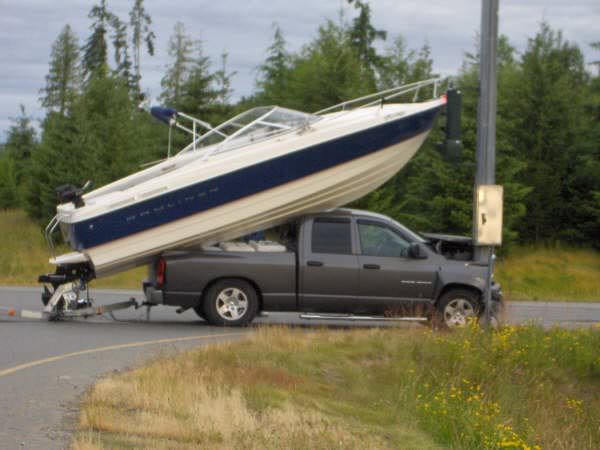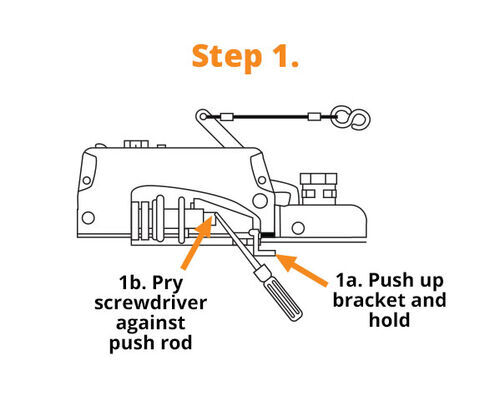
A ball ramp mechanism is used to load a clutch pack in a transmission inertia brake to slow a rotating shaft where an armature having an angled peripheral surface engages a. It is made to slide on a ledge into the back half of the neck.

The Brake Buddy once properly calibrated will then apply the brakes on your towed vehicle with proportional pressure.
How do inertia brakes work. According to RV technician Reg DeYoung the inertia brakes has an internal sensing device or a pendulum which senses the tow vehicles rate of deceleration. The sensing device then applies the amperage to the trailer brakes at the same rate of deceleration as the tow vehicle. Inertia can propel a driver through a cars front window during a crash if airbags do not cushion their movement.
Rolf Langohr A driver must apply the brakes to compensate for the intertia gravity creates as a car goes downhill. Inertia brakes are typically relatively low-capacity friction devices operated automatically or by overtravel of the clutch pedal. Examples of inertia brakes may be seen by reference to US.
A ball ramp mechanism is used to load a clutch pack in a transmission inertia brake to slow a rotating shaft where an armature having an angled peripheral surface engages a. Answer 1 of 2. Force of inertia has impact on every braking system irrespective of its type.
ABS is no exception. ABS has its own mini computer with sensors monitoring action of each wheel. Computer adjusts the intensity of braking.
An inertia brake on Eaton fuller auto shift gearboxes which are manual gearboxes that are automatically shifted is used to slow the input shaft so the transmission can go from neutral to. Inertia reels work by providing a quick-acting braking system that slows the descent of the worker should they fall from a height. Theyre attached to a harness which is worn by the employee this also needs to be of a top quality if its to provide the protection required as well as a safety cable or another secure anchor of some kind.
However when you apply your brakes the trailer or caravan tries to continue at the same speed inertia and travels forward in relation to the towing vehicle and compresses the drawbar and spring. This compression causes the lever to rotate pulling on the brake rod and operating the brakes. Red arrows image c Al-KO.
When the front neck is then pushed into the back that rod pushes into the master cylinder and then the brakes are applied. When the tow vehicle moves forward and releases the brakes the neck extends and releases the surge brakes. The rod can be modified for the brakes to come sooner or later whatever makes you feel more comfortable.
We all face it. Just look at the last article I wrote. It was months ago.
Writing a new Forbes piece has been on my list of things to do for a long time but why wasnt I getting to it. Surge brakesor sometimes referred to as inertia brakes are controlled by the push and pull of the vehicle. This engages the master cylinder that creates pressure in the brake lines by the use of fluid and puts pressure on the trailer drums or rotors depending on the trailer.
If at present you come home from work grab a bag of chips lie down on the couch and turn on the TV youll have a tendency to continue doing just that. Getting yourself to go out for a jog as soon as you get home from work instead of plopping down on the couch requires that you overcome inertia. The inertia chain brake is a very important safety feature of the modern chain saw.
It improves the safe use of the chainsaw in 3 separate ways. It acts as a hand guard protecting your left hand from being slapped and stabbed by tree branches while limbing bucking and clearing. When the front neck is pushed into the back half the rod is pushed into the master cylinder which then applies the brakes.
When the towing vehicle releases the brakes and moves forward the neck once more extends and releases the brakes. How surge brakes work. The neck of the trailer is two pieces.
The front section with the hitch attachment is a separate piece. It is made to slide on a ledge into the back half of the neck. A master cylinder for the brakes is mounted to the back half of the neck and has a rod extending from the master cylinder to the front half of the neck.
When you activate the brakes of your RV the device senses the inertia. The Brake Buddy once properly calibrated will then apply the brakes on your towed vehicle with proportional pressure. Theres a remote attachment that will stay up in the RV with you.
This small remote will alert you when the brakes on the towed vehicle are being applied. The anti-lock brake control module monitors the electromechanical components of the system. Malfunction of the anti-lock brake system will cause the anti-lock brake control module to shut off or inhibit the system.
However normal power-assisted braking remains. Loss of hydraulic fluid in the brake master cylinder will disable the anti-lock system. If playback doesnt begin shortly try restarting your device.
Videos you watch may be added to the TVs watch history and influence TV recommendations. To avoid this cancel and sign in to. Inertia-Based Trailer Brake Controller.
Also known as a proportional brake controller that uses an accelerometer an electrical component to sense the inertia or idleness of the tow vehicle. When the brake is activated the brake controller applies pressure to the trailer brakes depending on the vehicles momentum. An overrun brake called a surge brake when invented is a brake system commonly used on small trailers where the motion of the trailer with respect to the towing vehicle is used to actuate the brake.
The early systems were fitted with a spring system which was not very effective. Later systems were fitted with a sliding mechanism within the coupling which enables the drawbar. When the towing vehicle brakes inertia from the decelerating trailer drives a piston inside the master cylinder increasing the pressure of the hydraulic fluid all.
An inertia-activated controller unit mounted in the front of the car in view of the driver activates the boat trailer brakes as the driver brakes the tow vehicle. The controller features a display that informs you of its status and allows you to dial-in the amount of braking force that the system should use. This happens because of inertia with the surge brakes working hydraulically through the hitch.
As the tow vehicle slows the trailer presses harder against the hitch and compresses the braking actuator. The more the tow vehicle decelerates the more.